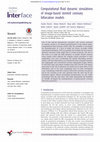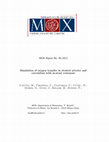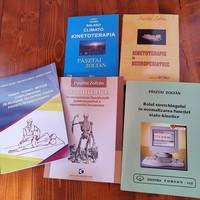Papers by Claudio Chiastra

13th IEEE International Conference on BioInformatics and BioEngineering, 2013
ABSTRACT The presence of stents within coronary arteries alters the hemodynamic condition. Comput... more ABSTRACT The presence of stents within coronary arteries alters the hemodynamic condition. Computational fluid dynamics (CFD) simulations offer the possibility to study local hemodynamics of a stented artery to identify the stimuli of instent restenosis, i.e. the local reduction of lumen size after stent deployment. The results of CFD simulations are more accurate when the analyses are performed with a model reproducing real in vivo conditions. For this purpose, optical coherence tomography (OCT) is a promising tool to reconstruct 3D geometries of stented coronary arteries, due to its higher resolution compared to the other imaging techniques. In the present work a reconstruction method of stented coronary bifurcation geometrical models starting from OCT images was developed. An OCT exam performed in a stented coronary bifurcation silicone sample was considered. The vessel and the stent were reconstructed separately, and then they were merged together. Vessel reconstruction was performed with a semi-automatic process: the main branch was reconstructed by fitting the lumen boundary with ellipses and subsequently by creating a mesh of the vessel; the side branch was created like an ideal cylinder. Stent struts were identified with an automatic algorithm; then, the stent was reconstructed in a manual way. After the creation of the 3D geometry of the bifurcation, a transient fluid dynamic simulation was carried out. CFD results showed that the highest risk of restenosis is located in the region near the bifurcation.
Numerical Mathematics and Advanced Applications 2011, 2012
ABSTRACT We address an immersed boundary method applied to the study of cardiovascular drug eluti... more ABSTRACT We address an immersed boundary method applied to the study of cardiovascular drug eluting stents deployed in coronary bifurcations. The problem involves the interaction of arterial deformations, hemodynamics and controlled drug release. Resorting to an immersed boundary method facilitates the handling of complex stent pattern and simplifies the definition of the mathematical model for drug release.

EuroIntervention, 2014
This study sought to investigate the possible influence of different bifurcation stenting techniq... more This study sought to investigate the possible influence of different bifurcation stenting techniques on stent deformation, physical stress, and drug elution using a virtual tool that includes structural, fluid dynamics and drug-eluting numerical models. A virtual bench test based on explicit dynamics modelling was used to simulate procedures on bifurcated coronary vessels performed according to three different stenting techniques: provisional side branch stenting, culotte, and Tryton-based culotte. Geometrical configurations obtained after virtual stenting simulations were used to perform fluid dynamics and drug elution analyses. The results showed that substantially different patterns of mechanical deformation, shear stress and theoretical drug elution were obtained using the different techniques. Compared with conventional culotte, the dedicated Tryton seems to facilitate the intervention in terms of improved access to the main branch and to lower its biomechanical influence on the coronary bifurcation in terms of mechanical and haemodynamic parameters. However, since the Tryton stent is a bare metal stent, the drug elution obtained is lower. Numerical models might successfully complement the information on stenting procedures obtained with traditional approaches such as in vitro bench testing or clinical trials. Devices dedicated to bifurcations may facilitate procedure completion and may result in specific patterns of mechanical stress, regional blood flow and drug elution.
Journal of Applied Biomaterials & Biomechanics, 2011
Over the last twenty years major advancements have taken place in the design of medical devices a... more Over the last twenty years major advancements have taken place in the design of medical devices and personalized therapies. They have paralleled the impressive evolution of three-dimensional, non invasive, medical imaging techniques and have been continuously fuelled by increasing computing power and the emergence of novel and sophisticated software tools. This paper aims to showcase a number of major contributions to the advancements of modeling of surgical and interventional procedures and to the design of life support systems. The selected examples will span from pediatric cardiac surgery procedures to valve and ventricle repair techniques, from stent design and endovascular procedures to life support systems and innovative ventilation techniques.
Medical Engineering & Physics, 2013

Journal of The Royal Society Interface, 2013
One of the relevant phenomenon associated with in-stent restenosis in coronary arteries is an alt... more One of the relevant phenomenon associated with in-stent restenosis in coronary arteries is an altered haemodynamics in the stented region. Computational fluid dynamics (CFD) offers the possibility to investigate the haemodynamics at a level of detail not always accessible within experimental techniques. CFD can quantify and correlate the local haemodynamics structures which might lead to in-stent restenosis. The aim of this work is to study the fluid dynamics of realistic stented coronary artery models which replicate the complete clinical procedure of stent implantation. Two cases of pathologic left anterior descending coronary arteries with their bifurcations are reconstructed from computed tomography angiography and conventional coronary angiography images. Results of wall shear stress and relative residence time show that the wall regions more prone to the risk of restenosis are located next to stent struts, to the bifurcations and to the stent overlapping zone for both investigated cases. Considering a bulk flow analysis, helical flow structures are generated by the curvature of the zone upstream from the stent and by the bifurcation regions. Helical recirculating microstructures are also visible downstream from the stent struts. This study demonstrates the feasibility to virtually investigate the haemodynamics of patient-specific coronary bifurcation geometries.

Journal of the Mechanical Behavior of Biomedical Materials, 2014
Although stenting is the most commonly performed procedure for the treatment of coronary atherosc... more Although stenting is the most commonly performed procedure for the treatment of coronary atherosclerotic lesions, in-stent restenosis (ISR) remains one of the most serious clinical complications. An important stimulus to ISR is the altered hemodynamics with abnormal shear stresses on endothelial cells generated by the stent presence. Computational fluid dynamics is a valid tool for studying the local hemodynamics of stented vessels, allowing the calculation of the wall shear stress (WSS), which is otherwise not directly possible to be measured in vivo. However, in these numerical simulations the arterial wall and the stent are considered rigid and fixed, an assumption that may influence the WSS and flow patterns. Therefore, the aim of this work is to perform fluid-structure interaction (FSI) analyses of a stented coronary artery in order to understand the effects of the wall compliance on the hemodynamic quantities. Two different materials are considered for the stent: cobalt-chromium (CoCr) and poly-l-lactide (PLLA). The results of the FSI and the corresponding rigid-wall models are compared, focusing in particular on the analysis of the WSS distribution. Results showed similar trends in terms of instantaneous and time-averaged WSS between compliant and rigid-wall cases. In particular, the difference of percentage area exposed to TAWSS lower than 0.4Pa between the CoCr FSI and the rigid-wall cases was about 1.5% while between the PLLA cases 1.0%. The results indicate that, for idealized models of a stented coronary artery, the rigid-wall assumption for fluid dynamic simulations appears adequate when the aim of the study is the analysis of near-wall quantities like WSS.
Journal of Biomechanics, 2012

Journal of Biomechanical Engineering, 2011
Despite their success, stenting procedures are still associated to some clinical problems like su... more Despite their success, stenting procedures are still associated to some clinical problems like sub-acute thrombosis and in-stent restenosis. Several clinical studies associate these phenomena to a combination of both structural and hemodynamic alterations caused by stent implantation. Recently, numerical models have been widely used in the literature to investigate stenting procedures but always from either a purely structural or fluid dynamic point of view. The aim of this work is the implementation of sequential structural and fluid dynamic numerical models to provide a better understanding of stenting procedures in coronary bifurcations. In particular, the realistic geometrical configurations obtained with structural simulations were used to create the fluid domains employed within transient fluid dynamic analyses. This sequential approach was applied to investigate the final kissing balloon (FKB) inflation during the provisional side branch technique. Mechanical stresses in the arterial wall and the stent as well as wall shear stresses along the arterial wall were examined before and after the FKB deployment. FKB provoked average mechanical stresses in the arterial wall almost 2.5 times higher with respect to those induced by inflation of the stent in the main branch only. Results also enlightened FKB benefits in terms of improved local blood flow pattern for the side branch access. As a drawback, the FKB generates a larger region of low wall shear stress. In particular, after FKB the percentage of area characterized by wall shear stresses lower than 0.5 Pa was 79.0%, while before the FKB it was 62.3%. For these reasons, a new tapered balloon dedicated to bifurcations was proposed. The inclusion of the modified balloon has reduced the mechanical stresses in the proximal arterial vessel to 40% and the low wall shear stress coverage area to 71.3%. In conclusion, these results show the relevance of the adopted sequential approach to study the wall mechanics and the hemodynamics created by stent deployment.
European Journal of Mechanics - B/Fluids, 2012

Biomechanics and Modeling in Mechanobiology, 2013
The treatment of coronary bifurcation lesions represents a challenge for the interventional cardi... more The treatment of coronary bifurcation lesions represents a challenge for the interventional cardiologists due to the lower rate of procedural success and the higher risk of restenosis. The advent of drug-eluting stents (DES) has dramatically reduced restenosis and consequently the request for re-intervention. The aim of the present work is to provide further insight about the effectiveness of DES by means of a computational study that combines virtual stent implantation, fluid dynamics and drug release for different stenting protocols currently used in the treatment of a coronary artery bifurcation. An explicit dynamic finite element model is developed in order to obtain realistic configurations of the implanted devices used to perform fluid dynamics analysis by means of a previously developed finite element method coupling the blood flow and the intramural plasma filtration in rigid arteries. To efficiently model the drug release, a multiscale strategy is adopted, ranging from lumped parameter model accounting for drug release to fully 3-D models for drug transport to the artery. Differences in drug delivery to the artery are evaluated with respect to local drug dosage. This model allowed to compare alternative stenting configurations (namely the Provisional Side Branch, the Culotte and the Inverted Culotte techniques), thus suggesting guidelines in the treatment of coronary bifurcation lesions and addressing clinical issues such as the effectiveness of drug delivery to lesions in the side branch, as well as the influence of incomplete strut apposition and overlapping stents.

Computational models are used to study the combined effect of biomechanical and biochemical facto... more Computational models are used to study the combined effect of biomechanical and biochemical factors on coronary in-stent restenosis, which is a post-operative remodeling and regrowth of the stented artery tissue. More precisely, we address numerical simulations based on Navier-Stokes and mass transport equations to study the role of perturbed wall shear stresses and reduced oxygen concentration in a geometrical model reconstructed from a real porcine artery treated with a stent. Joining in vivo and in silico tools of investigation has multiple benefits in this case. On one hand, the geometry of the arterial wall and of the stent closely correspond to a real implanted configuration. On the other hand, the inspection of histological tissue samples informs us on the location and intensity of in-stent restenosis. As a result of that, we are able to correlate geometrical factors, such as the axial variation of the artery diameter and its curvature, the numerical quantification of biochemical stimuli, such as wall shear stresses, and the availability of oxygen to the inner layers of the artery, with the appearance of in-stent restenosis. This study shows that the perturbation of the vessel curvature could induce hemodynamic conditions that stimulate an undesired arterial remodeling.
articles by Claudio Chiastra










Uploads
Papers by Claudio Chiastra
articles by Claudio Chiastra